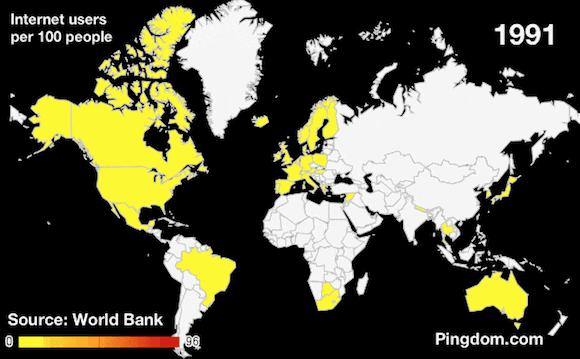 With an estimated 2 billion Internet users as of March 2011, about a third of the world’s population is online. That still leaves almost 5 billion people around the world that are not connected. In other words, there’s a huge potential to get more people connected in the coming years.
With an estimated 2 billion Internet users as of March 2011, about a third of the world’s population is online. That still leaves almost 5 billion people around the world that are not connected. In other words, there’s a huge potential to get more people connected in the coming years.
But things are developing fast. For most of us, an Internet connection at home and at work is something we’ve had for perhaps 15 years by now.
To better understand how fast it has developed, we used data from the World Bank to visualize Internet adoption over the past 20 years. Read on to see what we found out.
Staggering growth in number of Internet users
The World Bank’s statistics go back to 1991 and currently 2010 is the most recent year available. So we took the data for “Internet users (per 100 people),” basically Internet penetration, from 1991 to 2010 and created an animation. First, a few comments about the picture:
- The picture is an animated GIF. You may have to reload the page to see the animation again.
- In the animation, the redder a country is, the higher the Internet penetration is.
- In the animation, white means there is no data from the World Bank, or it’s less than 1 Internet user per 100 people.

Here are a few numbers that further highlight the stunning growth in Internet penetration:
- 1 – In 1991, no country had more than 1 Internet user per 100 people.
- 6 – In 1991, only six out of 216 countries registered with 1 Internet user per 100 people.
- 186 – The number of countries with an Internet penetration stated in the World Bank statistics for 2010.
- 96% – The highest Internet penetration in 2010 was in Iceland.
- 34.8% – The average Internet penetration per country in 2010.
- 31% – The median Internet penetration per country in 2010.
- 34% – The Internet penetration in China in 2010.
- 460 million – The number of Internet users in China in 2010.
- 79% – The Internet penetration in U.S. in 2010.
- 245 million – The number of Internet users in U.S. in 2010.
- 8% – The Internet penetration in India in 2010.
- 91.8 million – The number of Internet users in India in 2010.
Clear where the growth will be in the future
As amazing as it is that Internet has come so far in such a relatively short period of time, the potential that is yet to be realized is even more fantastic.
We noted last year that the biggest potential for growth in the number of Internet users is in countries like Brazil, China, India, Indonesia, and Nigeria. As people in these countries come online, and perhaps more so via mobile phones than computers, things will look very different in the next 20 years or so.
Note: For 2002-2004 Australia shows up as white. That is because there are no numbers in the World Bank data for Australia during those years.



























